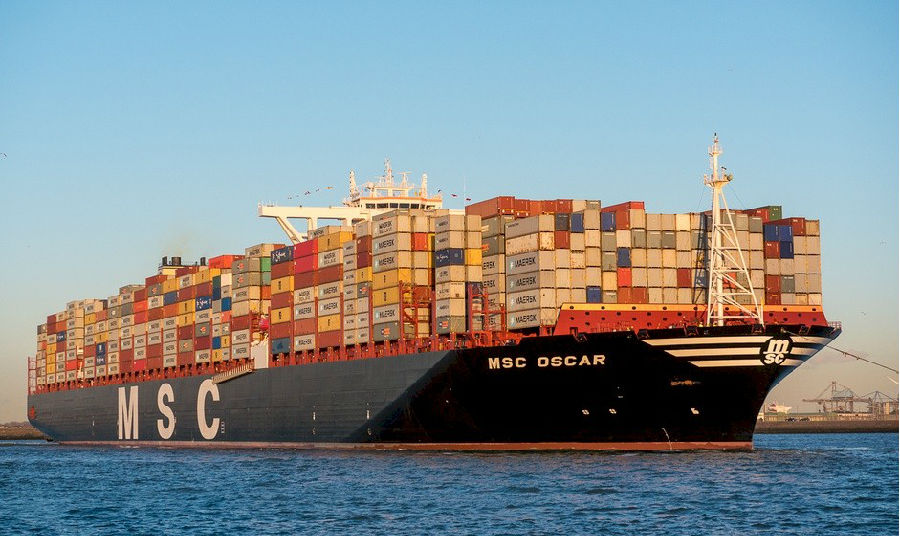This is the Empire State Building.
这是帝国大厦。
With 102 floors, it's one of the tallest buildings in the US.
它有102层,是美国最高的建筑之一。
But it's 4 floors shorter than the MSC Oscar.
但比起“地中海奥斯卡”,它还要矮4层。
Which isn't a building, but a boat: The largest container ship in the world.
但“地中海奥斯卡”并不是一栋建筑,而是一艘船:世界上最大的集装箱船。
Launched in January 2015, the MSC Oscar is nearly the size of four football fields laid end-to-end.
该船2015年1月下水,差不多有四个首尾相连的足球场那么大。
It has a draft of 16 meters, which means that if you were to stand at the bottom of the ship, you'd be 5 stories underwater.
吃水深度16米,也就是说,一个人站在船底的话,距离水面有5层之高。
It's one of 5000 container ships crossing the world's oceans,
该船也是横跨各大洋的5000艘集装箱船之一,
carrying the vast majority of products you buy and the parts those products were made from.
你购买的绝大部分产品及这些产品的零部件都要靠它运输。
These ships are the engine of the global economy, but 60 years ago, they didn't even exist.
这些船已经成为全球经济的引擎,但60年前,它们连存在都不存在。
How did all this happen?
这一切究竟是怎么发生的?
For hundreds of years, shipping was a bit of a nightmare.
数百年来,航运一直是人们的一个噩梦。
Goods had to be unloaded into storage at ports, then individually packed onto ships and unpacked afterwards.
商品要卸入港口的仓库,然后一个一个装上船,再拆箱。
This process was painfully slow and expensive, and it left items vulnerable to damage and theft.
这一过程不仅极其缓慢,成本也十分昂贵,还很容易造成物品损坏或被盗。
In 1956, Malcom McLean, an American trucking executive,
1956年,美国某卡车运输公司的主管马尔科姆·麦克林证明,
proved that you could save time and money by loading truck containers directly onto ships.
直接将卡车集装箱装载到轮船上既能够节省时间,还能节省成本。
On the other side they'd be put back onto trucks or trains, and reach their destination without ever being opened.
等到了收件地再将集装箱装回到卡车或者火车上,不用打开就能将其送到目的地。
McLean later got the government on board by using containerized service to help the military provide supplies for the Vietnam War.
后来,通过用集装箱帮助军队为越战官兵运送物资,麦克林让政府也上了他的车。
"Some of the more notable innovations in solving the logistical problems in Vietnam have been in the field of containerization."
“在解决越战官兵物资运送问题方面,比较引人注目的一个创新就是集装箱运输。”
After the industry recognized how efficient container shipping was, the use of container ships exploded.
业界认识到集装箱运输的效率之后,集装箱船的使用出现了爆炸式的增长。

International standardization was the key.
国际标准化是这一增长的关键。
The unit of measurement is TEU, or twenty-foot equivalent.
集装箱的测量单位是TEU,也即“20英尺换算单位”。
Most containers used today are twice as long.
今天使用的大多数集装箱的长度都是这一尺寸的两倍。
Shippers quickly realized that the larger the boat, the cheaper the shipping price per container.
航运公司的人很快就发现,船越大,每个集装箱的运费就越便宜。
So the size of the largest ships has grown exponentially.
最大船只的尺寸也就出现了指数级增长。
In 1999, a shipping executive predicted an eventual ceiling of 12,000 TEU.
1999年,航运业某高管预测,集装箱船大小的上限为1.2万个TEU。
But the MSC Oscar has a capacity of over 19,000.
但“地中海奥斯卡”的容量已经超过了1.9万个TEU。
To accommodate these huge ships, ports have been rebuilt,
要容纳这些巨大的船只,港口就必须重建,
with vast yards to store the containers and huge cranes to load and unload them simultaneously, in a specific order.
要有巨大的堆场来存放集装箱,还要有巨大的起重机按特定的顺序同时装卸集装箱。
Today's biggest ships are so huge that they can't actually fit through the Panama canal or dock at any American port.
如今,最大的集装箱船已经大到巴拿马运河都已经无法通航,也无法停靠在美国的任何一个港口。
They're used mostly for shipping between Europe and Asia.
这些船主要用于欧洲和亚洲之间的运输。
It's hard to overstate how much all this has transformed the world economy.
这一切对世界经济的影响要夸大也是很困难的。
After containerization, global trade in merchandise soared while insurance costs and inventories decreased.
货运集装箱化后,国际商品贸易大幅增长,保险成本和库存则有所下降。
Jobs at ports and in factories in the U.S. dropped
美国港口和工厂的工作岗位缩水,
while consumers gained access to a greater variety of products at a lower price.
但消费者能够以更低的价格买到更多种类的产品了。
As a result, products we buy can be made with parts from several different countries, by people on the other side of the world.
我们甚至可以买到世界另一头的人用几个国家生产的零部件制成的产品。
And it's hard to imagine any of this happening without someone first deciding to put the stuff in a box and put the box on a boat.
很难想象,最初如果没有一个人决定将这些东西放进一个箱子里再将箱子装船运输,这一切是否会实现。












